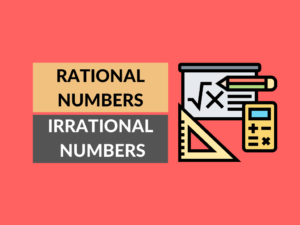The Difference Between Rational and Irrational Numbers
Rational and irrational numbers are two important concepts in mathematics. They both play a significant role in various mathematical calculations and applications. Understanding the differences between these two types of numbers is crucial for a solid foundation in mathematics. In this article, we will explore the definition, examples, uses, and key differences between rational and irrational numbers.
What are Rational Numbers?
Rational numbers are real numbers that can be expressed as the quotient or fraction of two integers, where the denominator is not zero. In other words, any number that can be written in the form of p/q, where p and q are integers and q ≠ 0, is a rational number. The word “rational” is derived from the word “ratio.”
Examples of Rational Numbers:
- 4/5
- 2/3
- 8/2
- 5/1
- -7/9
Uses of Rational Numbers:
Rational numbers are used in a variety of real-life situations, including:
- Money transactions and calculations
- Measurements and conversions
- Probability and statistics
- Geometry and trigonometry
- Data analysis
What are Irrational Numbers?
On the other hand, irrational numbers are real numbers that cannot be expressed as the quotient or fraction of two integers. Unlike rational numbers, irrational numbers cannot be represented exactly by decimals or fractions, and their decimal expansions go on infinitely without repeating patterns.
Examples of Irrational Numbers:
- √2
- π (pi)
- e (Euler’s number)
- √7
- √11
Uses of Irrational Numbers:
Irrational numbers are encountered in various areas of mathematics and applications, including:
- Geometry (calculating the lengths of diagonals)
- Trigonometry (calculating sine, cosine, and tangent values)
- Statistics (calculating probabilities)
- Fractals and chaos theory
- Physics and engineering
Differences Between Rational and Irrational Numbers:
| Difference Area | Rational Numbers | Irrational Numbers |
|---|---|---|
| Rationality | Can be expressed as fractions or decimals | Cannot be expressed as fractions or decimals |
| Termination of Decimal Expansion | Has a terminating or repeating decimal expansion | Has a non-terminating and non-repeating decimal expansion |
| Representation | Can be represented as a ratio of two integers | Cannot be represented as a ratio of two integers |
| Examples | 1/3, 5/8, 7/2, -2/5 | √2, π (pi), e, √7 |
| Countability | Countable, with an infinite number of members | Uncountable, with an infinite number of members |
| Operations | Closed under addition, subtraction, multiplication, and division | Not closed under all operations |
| Probability | The probability of selecting a rational number from the real number line is zero | The probability of selecting an irrational number from the real number line is one |
| Application | Used in various practical applications like measurements, calculations, and statistics | Used in advanced mathematical fields like geometry, physics, and engineering |
| Fractions | All fractions are rational numbers | There are no irrational fractions |
| Root Values | Square roots are either rational or irrational | Square roots can be irrational numbers |
Conclusion:
In conclusion, rational numbers can be expressed as fractions or decimals, have a terminating or repeating decimal expansion, and can be represented as a ratio of two integers. On the other hand, irrational numbers cannot be expressed as fractions or decimals, have a non-terminating and non-repeating decimal expansion, and cannot be represented as a ratio of two integers. Irrational numbers are encountered in advanced mathematical fields and have numerous practical applications. Understanding the differences between rational and irrational numbers is crucial for various mathematical calculations, as well as real-life applications.
People Also Ask:
Q: What are the main differences between rational and irrational numbers?
A: The main differences between rational and irrational numbers include their representation, decimal expansion, countability, application in mathematics, and the probability of selecting them from the real number line.
Q: Can rational numbers be written in decimal form?
A: Yes, rational numbers can be expressed as decimal numbers. They can either have a terminating or repeating decimal expansion.
Q: Is zero a rational number?
A: Yes, zero is a rational number as it can be represented as the fraction 0/1.
Q: Are all fractions irrational numbers?
A: No, all fractions are rational numbers. Irrational numbers cannot be expressed as fractions.
Q: Are there more rational or irrational numbers?
A: Irrational numbers are actually more abundant than rational numbers, as they are uncountable and have an infinite number of members.



